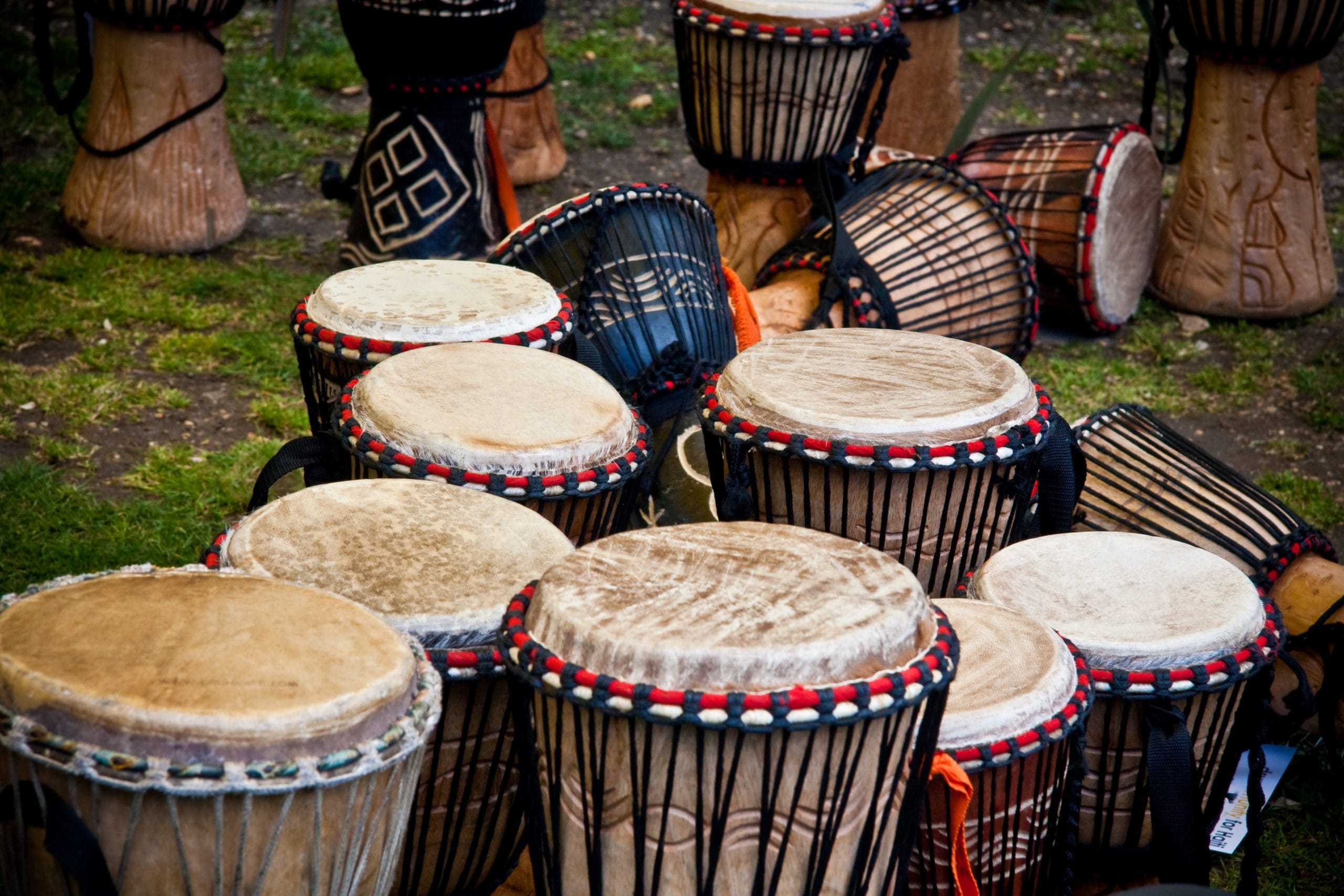Dive into the captivating world of the djembe, a powerful hand drum resonating with the heart of West Africa. From its rich history and intricate craftsmanship to its mesmerizing rhythms and cultural significance, this guide unveils the magic of the djembe, inviting you to join its vibrant journey.
A Drum with a Story: The Djembe’s Origins
The djembe isn’t just a drum; it’s a living narrative. Shaped like a goblet, carved from a single piece of hardwood (like mahogany or iroko), and crowned with animal skin, each djembe whispers tales of generations past. Its story likely begins with the Mandinka blacksmiths (Numu) around 1200 AD, skilled artisans who birthed these instruments, not merely as percussion, but as a voice – a powerful expression of ceremony, ritual, and celebration. The djembe gained wider recognition after West African decolonization in the 1950s, carrying its vibrant rhythms to a global stage.
The deep, resonant bass tones mingle with sharp, crisp slaps, each beat a word, each rhythm a sentence in a language understood by the soul. This isn’t mere speculation; the djembe’s influence has probably shaped musical traditions worldwide. Today, its distinctive voice resonates in modern fusion bands, traditional West African villages, therapeutic settings, and drumming circles, creating spaces for meditation, healing, and connection.
The Language of the Djembe: Jembe vs. Djembe
The terms “jembe” and “djembe” often cause confusion. “Djembe,” influenced by French orthography, is the most common spelling. However, “jembe” and other variations are closer to pronunciations in some West African languages. Some linguists suggest “jembe barra,” meaning “unity drum” in Malinke, is the original name, implying a communal purpose from its inception. Another theory connects the name to the drum’s construction – “djem” (wood) and “be” (goat) – reflecting the traditional materials used.
Regardless of spelling, the name hints at the drum’s rich history and diverse linguistic influences. Whether “jembe” or “djembe,” this drum has a powerful story to tell. This combination of wood and goatskin, tensioned to perfection, creates the djembe’s unique and powerful sound, capable of expressing a wide range of tones, from deep bass to sharp slaps.
| Topic | Details |
|---|---|
| Common Spelling | Djembe (influenced by French) |
| Other Spellings | Jembe, and variations, closer to some West African pronunciations. |
| Possible Origin | “Jembe barra” (unity drum) in Malinke, suggesting a communal purpose. Also possibly from “djem” (wood) and “be” (goat). |
| Construction | Carved hardwood body (e.g., mahogany, iroko) with goatskin head. |
| Sound | Wide range of tones produced by various hand techniques. |
| Cultural Role | Integral to West African ceremonies, rituals, celebrations, storytelling, and social gatherings. |
| Global Reach | Popular worldwide in diverse musical genres and cultural practices. |
Mastering the Rhythms: The Four Fundamental Djembe Hits
The djembe’s sonic versatility comes from four fundamental hits:
- Bass (dunun): The deep, resonant heartbeat, created by striking the center of the drumhead with a flat hand.
- Tone (open): The clear, ringing melody, produced by striking the edge of the drumhead with slightly cupped hands.
- Slap (pa): The sharp, high-pitched crack, achieved by striking the rim with flat fingers, allowing them to bounce off.
- Touch (ta): The soft, subtle whisper, made by gently touching the drumhead with your fingers.
These hits, combined with variations in hand tension, striking point, and angle, create the complex polyrhythms characteristic of djembe music. This rhythmic language, often passed down through oral tradition, varies regionally, offering a rich tapestry of musical expression.
| Hit | Sound Description | Hand Position | Drumhead Contact Point |
|---|---|---|---|
| Bass | Deep, resonant thump | Flat hand | Center |
| Tone | Clear, ringing note | Slightly cupped hands | Edge |
| Slap | Sharp, high-pitched crack | Flat fingers | Rim |
| Touch | Muted, quiet tap | Gentle finger touch | Drumhead |
More Than Music: The Djembe’s Cultural Significance
Beyond its musicality, the djembe is deeply woven into the cultural fabric of West Africa. It serves as a storyteller, conveying messages and narratives through its rhythms, especially in areas where other communication forms were limited. It plays a vital role in ceremonies and rituals, marking significant life events like births, weddings, and funerals. Some cultures attribute spiritual significance to the djembe, believing it connects players to the spiritual world. Today, its use extends to therapeutic settings, promoting emotional expression, stress reduction, and community building.
| Traditional Uses | Modern Uses |
|---|---|
| Ceremonies & Rituals | Musical Performances |
| Communication | Drumming Circles |
| Spiritual Significance | Therapeutic Applications |
The djembe’s journey reflects its adaptability. Its captivating rhythms now resonate globally, influencing diverse musical genres from traditional West African music to jazz and even pop. Its presence in drumming circles fosters connection and shared creative experiences. Ongoing research continues to explore the djembe’s therapeutic potential, suggesting a future rich with possibilities.
The djembe is more than just a drum; it’s a vibrant testament to human expression, connecting us to the past, enriching our present, and resonating into the future. Whether accompanying a Dirks knife on an outdoor adventure, or enriching a cultural experience, the djembe holds a unique place in human experience.
- Unlock Water’s Symbolism: A Cross-Cultural Exploration - April 20, 2025
- Identify Black and White Snakes: Venomous or Harmless? - April 20, 2025
- Unlocking Potential: Origins High School’s NYC Story - April 20, 2025















